Shengmin Guo

Jack Holmes Professorship in Mechanical Engineering
3290L Patrick F. Taylor Hall
Department of Mechanical & Industrial Engineering
Louisiana State University
Baton Rouge, LA 70803
225-578-7619
Educational Background
- D.Phil., Engineering Science, University of Oxford, 1998
- M.Eng., Fluid Mechanics, Tsinghua University, 1993
- B.Eng., Engineering Mechanics, Tsinghua University, 1991
Research Goal
Provide challenges and opportunities for future engineers and high-tech leaders.
Research Overview
Dr. S.M. Guo is a professor in Department of Mechanical and Industrial Engineering and the Director of Turbine Innovation and Energy Research (TIER) center at Louisiana State University. He is also a Louisiana registered professional engineer. Dr. Guo was a lecturer at the University of Oxford (England) and the University of Manchester Institute of Science and Technology (England) from 1998 to 2004. He joined LSU Mechanical Engineering Department in August 2004 as an Assistant Professor and was promoted to Professor in 2014. Dr. Guo’s research activities are in the fields of thermal fluids, instrumentation, power generation, laser additive manufacturing, and high temperature materials. Dr. Guo has established a track-record on gas turbine aerodynamics and heat transfer, fuel cells, plasma spray coatings, high temperature ceramics and alloys, and advanced manufacturing. His research projects are funded by NSF, NASA, DOE, Air Force, LaSPACE, Louisiana Board of Regents, and industry. His current research focus is on laser based additive manufacturing.
Projects
To understand selective laser melting (SLM) process, we recently studied the effect of partially absorbing and reflective substrates on the radiative transport process of thin particulate layers. Radiative transport process for thin particulate layers is studied using a ray tracing method. A simple cubic arrangement is considered to simulate the SLM particulate bed. Both specular and diffuse types of reflections are used for the particles and lambertian reflection is used for the reflective substrate. The results show that substrate reflection becomes dominant when decreasing the layer thickness while keeping the diameter constant or increasing the diameter of the particles in the bed while keeping the layer thickness constant.
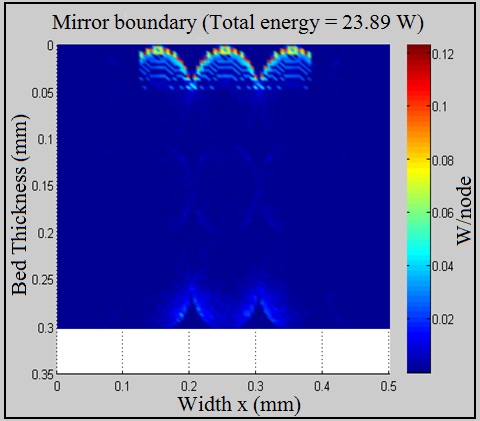
Figure 1 Energy absorbed by particles for a perfectly reflecting boundary.
To improve the part’s quality for metal 3D printing, we examined dross formation mechanisms. The composition of dross formed on SLM specimens as well as the effects of supporting structures on dross formation was studied. The major impact of dross formations in SLM is the development of poor geometrical replications.
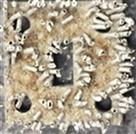
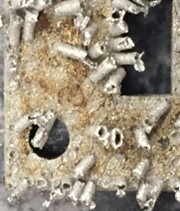
Figure 2 Dross formation in the overhang regions (the yellowish color regions).
To understand the quality of 3D printed metal parts, we further studied porosity imaging of laser melted stainless steel 316 with spatially resolved small angle neutron scattering, in collaboration with Prof. Butler, LSU Chemistry Department. Neutron scattering imaging was used to investigate the sub-micron porosity of the prepared objects.
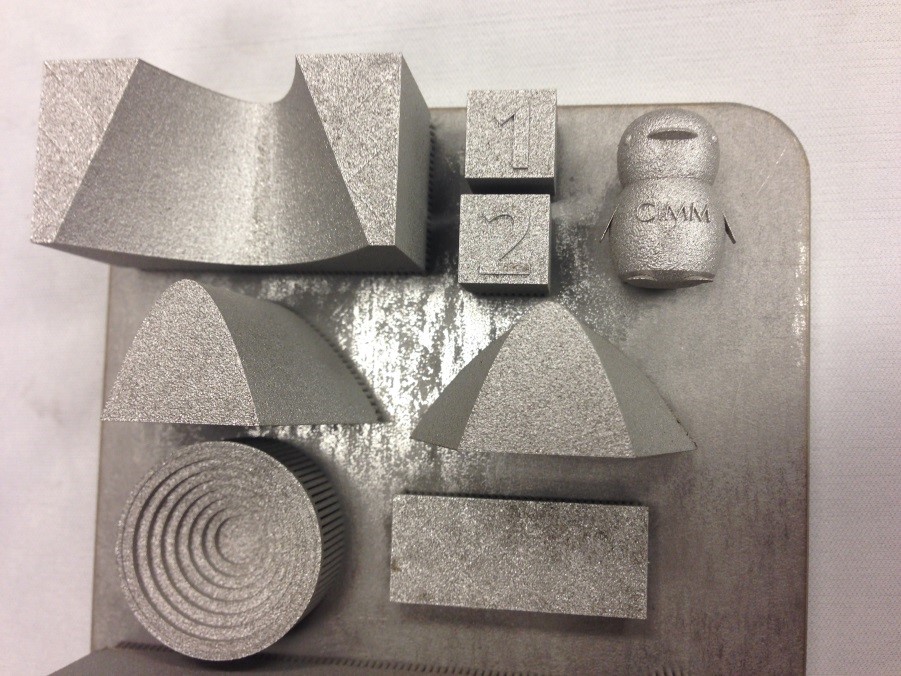
Figure 3 3D printed stainless steel parts for Neutron testing.
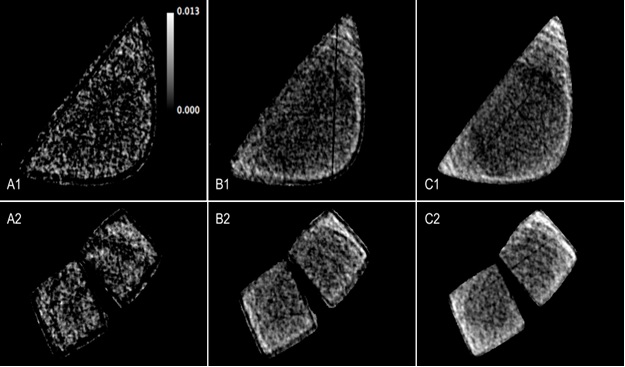
Figure 4 Dark-field image cross-sections at multiple grating spacings, D. The upper row shows the unpolished quadratic section and the bottom row shows the cubes. (A1, A2) D = 3mm, (B1, B2) D = 6mm, (C1, C2) D = 9mm.
To obtain atomic level information regarding the 3D printed metal parts, we conducted defect analysis of selective laser melted parts by positron annihilation spectroscopy, in collaboration with Prof. F. Y.Lu of LSU Mechanical Engineering Department. Different SLM processing parameters were examined.
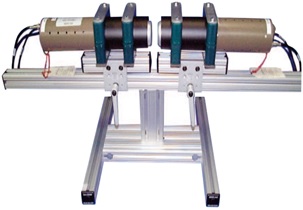
To understand the laser melting and solidification processes, we conducted thermophysical property measurements of liquid metal alloys by electrostatic levitation, in collaboration with Prof. J. R. Raush of ULL, Prof. W. J.Meng of LSU, and NASA MSFC
Vacuum electrostatic levitation (ESL) is a technique through which thermophysical property measurements on metallic liquids can be accomplished without physical contact. Ti-Al-V-Mo quaternary alloy was studied for laser-based 3D printing, and showed improved mechanical properties over traditional β Ti alloys. We performed ESL measurements on molten Ti-based alloys, including elemental Ti, Ti-Al binaries, Ti-6Al-4V, and Ti-6Al-4V-10Mo, through a container-less oscillating drop technique. Thermophysical property results (melting temperature, density, viscosity, and surface tension) are compared with published results, while those for Ti-6Al-4V-10Mo are reported here for the first time.
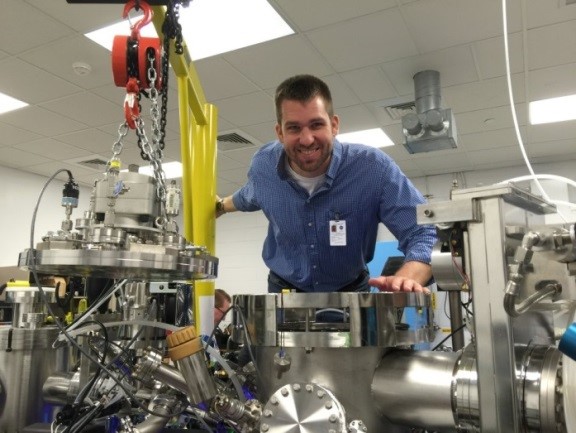
Figure 5 Prof. J.R. Raush performing tests at NASA MSFC.
We also examined novel alloys which can be used for laser additive manufacturing. One such idea is the development of novel refractory high entropy alloys. CALPHAD simulations have been performed to predict the alloy phase formations during the solidification process. Experimental characterizations using XRD, SEM and TEM were performed to validate the simulation results. Good agreements were found.
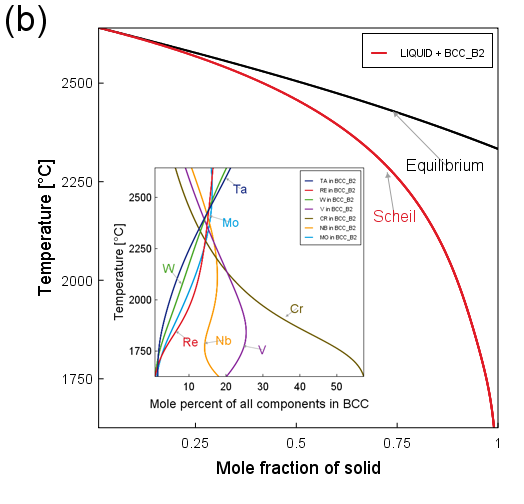
Figure 6 Non-equilibrium solidification using Scheil model on CrMoNbReTaVW
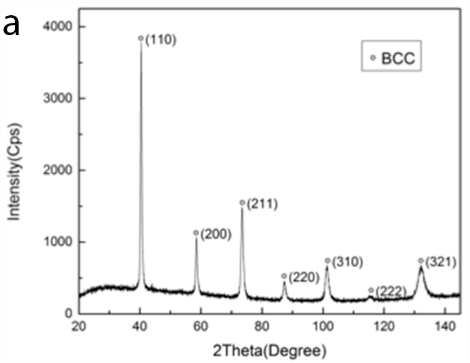
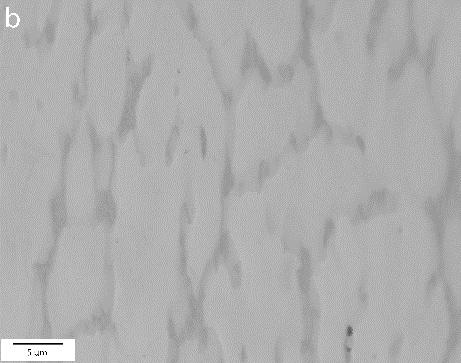
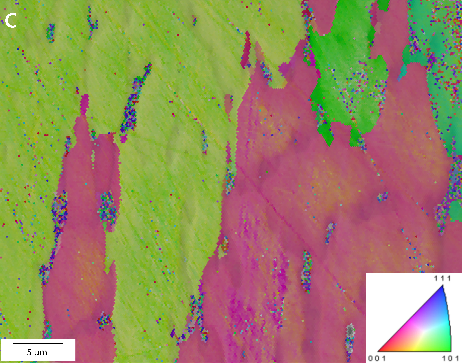
Figure 7 (A) XRD pattern with the EBSD mapping (C) of region (B) in as-solidified CrMoNbReTaVW alloy.
In collaboration with Prof. Sprunger of LSU Physics Department, we studied the electronic and microstructural properties of high entropy alloys via X-ray powder diffraction (XRD), as well as X-ray absorption near-edge structure (XANES) and extended X-ray absorption fine structure (EXAFS) spectroscopy. XANES reveals subtle changes in metallic edge structure compared to single-phase elemental samples.
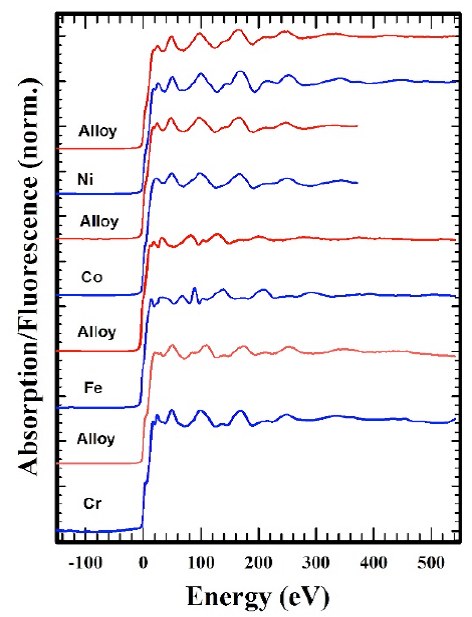
Figure 8 EXAFS spectra of Cr, Fe, Co, and Ni elements in both the CoCrFeNi alloy (red lines) and the corresponding pure metal foils (blue).
Selected Publications
Novel Ceramics, Alloys, and Composites
- Zhou Wang, Aravindkumar Vemishetti, John I Ejembi, Guodong Wei, Boliang Zhang, Li Wang, Yi Zhang, Shengmin Guo, Jia Luo, Corin Chepko, Qilin Dai, Jing-Ke Tang, Guang-lin Zhao, 2016, High thermoelectric performance of fullerene doped Bi5Sb1.5Te3 alloys, Materials Science and Engineering B 205 (2016) 36–39
- Zhang, M.C. Gao, Y. Zhang, S.M. Guo, 2015, Supporting Data for Senary Refractory High-Entropy Alloy CrxMoNbTaVW, Data in Brief, Volume 5, Pages 730–735, DOI:10.1016/j.dib.2015.10.027
- Yi Zhang, Zhou Wang, Boliang Zhang, Guang-Lin Zhao, S.M. Guo, 2015, The electromagnetic interference shielding effectiveness of high aspect-ratio SiC nanofibers/epoxy composites, RSC Advances, RSC Advances, 2015, 5, 93499 – 93506. DOI: 10.1039/C5RA16007C
- Zhang, M.C. Gao, Y. Zhang, S.M. Guo, Senary Refractory High-Entropy Alloy CrxMoNbTaVW, Journal of Calphad, v51, No.12, pp. 193-201, (2015) DOI: 10.1016/j.calphad.2015.09.007
- Michael Gao, Boliang Zhang, Shizhong Yang, and Shengmin Guo, Senary Refractory High-Entropy Alloy HfNbTaTiVZr, Metallurgical and Materials Transactions A. Paper #: E-SYMP-15-852-AR. DOI: 10.1007/s11661-015-3105-z
- Yi Zhang, Zhou Wang, Boliang Zhang, Chengjun Zhou, Guang-Lin Zhao, Jiechao Jiang, S.M. Guo, 2015, Morphology and electromagnetic interference shielding effect of SiC coated carbon short fibers, Journal of Materials Chemistry C, DOI: 10.1039/C5TC01987G. 2015, 3, 9684 - 9694
- Zhang, M.C. Gao, Y. Zhang, S. Yang, S.M. Guo, 2015, Senary Refractory High-Entropy Alloy MoNbTaTiVW, Materials Science and Technology, v31, No.10, 1207-1213, DOI: 10.1179/1743284715Y.0000000031
- Li, G. L. Zhao, P. Zhang, S. Guo, J. Tang, 2012, Thermoelectric Performance of Micro/Nano-Structured Bismuth-Antimony-Telluride Bulk from Low Cost Mechanical Alloying, Materials Sciences and Applications, 2012, 3, 833-837
- Peigen Zhang, K.Y. Wang, S.M. Guo, 2010, Large-Scale Synthesis of AlN Nanofibers by Direct Nitridation of Aluminum, Ceramics International, Vol 36, 2209-2213, (selected as the cover story of the issue)
- Luping Li, Peigen Zhang, Jiandong Liang, and S.M. Guo, 2010, Phase Transformation and Morphological Evolution of Electrospun Zirconia Nanofibers During Thermal Annealing, Ceramics International 36 (2010) 589–594
Advanced Manufacturing
- Lu, F. Mei, W.Meng, S.M.Guo, 2013, Fabrication of Metal-based Micro-channel Heat Exchangers and Quantification of their Liquid Flow and Heat Transfer Characteristics, Heat Transfer Engineering, Volume: 34 Issue: 1 Pages: 15-28 DOI: 10.1080/01457632.2013.694733.
- Jiandong Liang, Shengmin Guo, Muhammad A. Wahab, 2013, Localized Surface Modification on 1018 Low Carbon Steel by Electrolytic Plasma Process and Its Impact on Corrosion Behavior, Industrial Heating and HTPro, 2013 HTS/Bodycote Best Paper in Heat Treating Award
- Xiaotun Qiu, Rui Tang, Ranran Liu, Hai Huang, S.M. Guo, Hongyu Yu, 2012, A Micro Initiator Realized by Reactive Ni/Al Nanolaminates, Journal of Materials Science: Materials in Electronics, DOI 10.1007/s10854-012-0726-5
- Liang, K.Y. Wang, S.M. Guo, M.A. Wahab, 2011, Influence of Electrolytic Plasma Process on Corrosion Property of Peened Surface on a 304 Austenitic Stainless Steel, Materials Letters, Volume 65, Issue 3, Pages 510-513
- Xiaotun Qiu, Ranran Liu, Shengmin Guo, Jesse Harris Graeter, Laszlo Kecskes, Jiaping Wang, 2009, Combustion Synthesis Reactions in Cold-Rolled Ni/Al And Ti/Al Multilayers, Metallurgical and Materials Transactions A, Volume 40, Issue7, Page 1541-1546
Plasma Spray Coatings
- H. Habibi, S.M. Guo, 2015, The Hot Corrosion Behavior of Plasma Sprayed Zirconia Coatings Stabilized with Yttria, Ceria, and Titania in Sodium Sulfate and Vanadium Oxide, Materials and Corrosion, v 66, n 3, p 270-277, March 1, 2015 DOI: 10.1002/maco.201307331
- Wang, M.H.Habibi, J.I. Eldridge, S.M. Guo, 2014, Infrared radiative properties of plasma-sprayed BaZrO3 coatings, Journal of the European Ceramic Society, 34(2014)3941–3949, DOI: 10.1016/j.jeurceramsoc.2014.05.015
- Wang, Jeffrey I. Eldridge, S.M. Guo, 2014, Comparison of Different Models for the Determination of the Absorption and Scattering Coefficients of Thermal Barrier Coatings, Acta Materialia, v 64, p 402-410
- Wang, Jeffrey I. Eldridge, S.M. Guo, 2013, Thermal Radiation Properties of Plasma-Sprayed Gd2Zr2O7 Thermal Barrier Coatings, Scripta Materialia, Volume 69, Issue 9, November 2013, Pages 674–677, DOI: 10.1016/j.scriptamat.2013.07.026
- H. Habibi, Li Wang, Jiandong Liang, and S.M. Guo, 2013, An Investigation on Hot Corrosion Behavior of YSZ-Ta2O5 in Na2SO4+V2O5 Salt at 1100˚C, Corrosion Science, V75, No.10. pp 409-414.
Fuel Cells
- B. Mahmud Hasan, M.A. Wahab, S.M. Guo, 2011, CFD Analysis of a PEM Fuel Cell for Liquid Dispersion at the Interface of GDL-GFC, International Journal of Numerical Methods for Heat & Fluid Flow, Vol. 21 Iss: 7, pp.810 - 821
- Luping Li, Peigen Zhang, S.M.Guo, 2011, Electroless Coating of Nickel on Electrospun 8YSZ Nanofibers, Ceramic Transactions, v 227, p 69-79, Advances in Materials Science for Environmental and Nuclear Technology II; ISSN: 10421122; ISBN-13: 9781118060001
- Luping Li, Peigen Zhang, Ranran Liu, and S.M. Guo, 2011, Preparation of Fibrous Ni-coated-YSZ anodes for SOFCs, Journal of Power Sources, vol 196, no.3, pp.1242-1247, DOI: 10.1016/j.jpowsour.2010.08.038
- Bajon, S. Balaji, S.M. Guo, 2009, Electrospinning Nafion Nano fiber for PEMFC application, ASME Journal of Fuel Cell Science and Technology, V6, 031004
- M. Guo, A.B.M. Hasan, 2009, Proton Exchange Membrane Fuel Cell High Carbon Monoxide Tolerance Operation using Pulsed Heating and Pressure Swing, ASME Journal of Fuel Cell Science and Technology, Vol.6, No.1, 011022
Gas Turbine, Aerodynamics and Heat Transfer
- Wen-zhong Xie, Guang-fu Ma, Rong-wei Guo, Hao Chen, Yu-fen Wen, Shengmin. Guo, 2016, Flow-Based Limiting Internal Contraction Ratio Predictive Tool for Self-starting of Two-dimensional Hypersonic Inlets, Journal of Propulsion and Power, Vol. 32, No. 2 (2016), pp. 463-471.
- Jeff Kornuta, Shengmin Guo, 2010, Momentum Exchange Tether as a Hypersonic Parachute for Manned Re-Entry, Journal of Spacecraft and Rockets, DOI:10.2514/1.48126, Volume 47, Number 4, pp571-580
- Pomfret, J. R., Guo, S.M., Oldfield, M.L.G. and Rawlinson A.J, 2002, A High-Speed Concentration Probe for the Study of Gas Turbine Vane Film Cooling, Journal of Measurement Science and Technology, Vol 13 pp 1966-1974
- Sargison J.E., Guo S.M., Oldfield M.L.G., Lock, G.D., Rawlinson A.J, 2002, A Converging Slot-Hole Film-Cooling Geometry. Part 2 Transonic Nozzle Guide Vane Heat Transfer and Loss, Transactions of the ASME: Journal of Turbomachinery, Vol. 124, pp 461-471, ASME 2001 Best Paper Award
- Piccini E., Guo S.M., Jones T.V., 2000, The Development of a New Direct Heat Flux Gauge for Heat Transfer Facilities, Journal of Measurement Science and Technology, Vol 11 No.4 pp342-349
Selected Grants
(31 Federal, State, and Industrial Research Grants awarded in the last 11 years.)
- A Selective Laser Melting System to Enhance Advanced Manufacturing Research and Education, Louisiana BOR
- NSF Consortium for Innovation in Manufacturing and Materials (CIMM)
- Thermophysical Properties Measurements on Metallic Liquids for Metal 3D Printing, Louisiana BOR
- A Novel Powder Feeder for Selective Laser Melting Based 3D Printers, Louisiana BOR